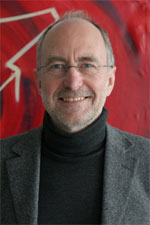|
Dr. rer.nat., University of Regensburg (1975)
Heisenberg fellow (1983 - 1987)
Professor of Theoretical Physics, Universities of Würzburg (1988 - 1989), Frankfurt (1989 - 1996), and Göttingen (since 1996)
Director, Max Planck Institute for Dynamics and Self-Organization, Göttingen (since 1996)
|
|
Nonlinear dynamics has made considerable progress in recent years in providing concepts and methods for the investigation of dynamical phenomena occurring in complex natural systems. The world of spatially extended and multi-unit nonlinear dynamical systems still reserves many surprises. It puts forth phenomena one would neither have guessed nor understood without quantitative mathematical modeling. In the realm of spiking neuronal networks, e.g. we have discovered a phenomenon of switching among synchronized states caused by unstable attractors, something most physicists would consider a contradictio in adjecto. They can provide a neuronal network with a high degree of flexibility to adapt to permanently changing tasks, but would not have unveiled their nature merely from an experimental observation without modeling.
The methods of nonlinear dynamics also lend themselves to other applications in neuroscience from the level of single cells to the level of cell assemblies and large cortical networks, from the time scales of action potentials (milliseconds) to the time scales of learning and long-term memory (up to years). My work in the past has dealt among others with studies of stochastic resonance of single neurons under periodic and endogenous stimulation, detailed investigations of the properties, functions, and conditions of neuronal synchronization, and the development of neuronal maps in the visual cortex. We have elucidated the influence of the network topology on synchronization and other dynamical properties and demonstrated the existence of speed limits to network synchronization due to disordered connections. Besides, I am also focusing on other applications of nonlinear dynamics, e.g. in mathematical models for the description and forecast of the epidemic spreading.
|
|
Address:
Dept. of Nonlinear Dynamics
MPI for Dynamics and Self - Organization
Bunsenstr. 10
37073 Göttingen
phone:+49-551-5176-400
fax:+49-551-5176-402
e-mail: 
Further Information:
http://www.chaos.gwdg.de/
|
|
D. Brockmann, L. Hufnagel, T. Geisel (2005): The Scaling Laws of Human Travel. Nature 439,462-465
F. Wolf, M. Timme and T. Geisel. (2004): Topological speed limits to network synchronization. Phys. Rev. Lett., 92:074101
M. Denker, M. Timme, M. Diesmann, F. Wolf and T. Geisel (2004): Breaking Synchrony by Heterogeneity in Complex Networks. Phys. Rev. Lett., 92:974193
F. Wolf and T. Geisel (2003):Universality in visual cortical pattern formation. Journal of Physiology - Paris, 97:253-264
M. Timme, F. Wolf, and T. Geisel (2002): Prevalence of unstable attractors in networks of pulse-coupled oscillators. Phys. Rev. Lett., 89(15):154105
F. Wolf and T. Geisel (1998): Spontaneous pinwheel annihilation during visual development. Nature, 395:73-78, 1998.
Hufnagel L, Brockmann D, Geisel T (2004) Forecast and Control of Epidemics in a Globalized World. PNAS 101: 15124
|
|
|
